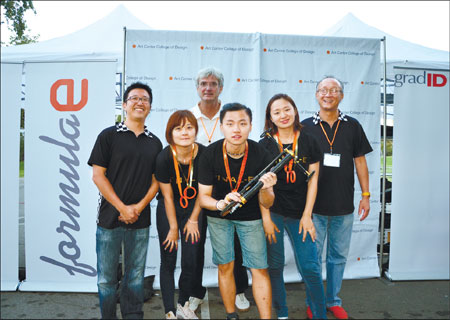Beijing design students win grand prize
|
Final-E team members, wearing ribbons, with Andy Ogden (third from left), chair of graduate industrial design, and other faculty members from GradID Art Center at the Formula-E award ceremony in Los Angeles on Aug 8. Liu Yiyi / China Daily |
What can you do with a 16-inch rubber band? Why not ask some of the third-term industrial design students at the Art Center College of Design in California last week. The school hosted its 8th annual Formula-E races, in which students must design, build and race rubber band-powered cars.
Dubbed the Formula-E Race ("E" for elastic) the exercise started as part of the curriculum for the Art Center's Graduate Industrial Design (GradID) but it has grown into something of an international competition.
In this year's Formula-E, teams from three Southern California universities and two universities in China - Beijing University of Technology and Tsinghua University - wound up stretching their engineering imaginations to the max. In all, 51 students and five faculty members traveled to the US from China for the event.
This year's event marked the second time that teams from China participated and the first time teams - 16 in all - from three Beijing universities competed in their own preliminary Formula-E race "playoffs" in China prior to the "World Series" finals in the US.
The Formula-E Race event has five awards: Best in Show; the Sinclaire Hill Climb; the Ashtray Drag Race; the Figure 8; and Best Design. Two teams from China - Final-E and Energy+ of Beijing University of Technology made a good showing at the competition.
Final-E won Best in Show and the hill climb, and took second place in the drag race and best design. Final-E team members - Sui Hao, Xuan Jinran and Zhang Han - said they were very happy with their achievements but they also said they could have done a better job if they had been more familiar with the very challenging track.
The Energy+ team took third place in best design, winning praise from one of the judges - Two Bit Circus' Eric Gradman - for its "simple and innovative" crossbow design.
This was the second time Liao Wei, coach and teacher of Final-E and Energy+, got students ready for Formula-E. Last year, Beijing University of Technology was the only Chinese school participating in the competition.
Liao invited Tsinghua University and Shandong University to join the games and held races in China this year. He said the game was a very valuable experience for students, and he wants to invite more universities and even businesses to join the competition in the future.
Liao also said he was trying to make Formula-E racing part of the curriculum at Beijing University of Technology. Preparation for the competition took students 13 weeks working in their spare time, a heavy burden outside their school work, he said.
Lorne Buchman, president of the Art Center College of Design, said he welcomes the chance to interact with China. "We're first and foremost interested in opportunities for our students to have international experiences," he said. "This is the world they'll be moving into when they graduate. What's happening now in China is incredibly exciting and dynamic. Our students are very interested in exploring and exchanging ideas with designers in China."
Buchman said that "on a deeper level, Formula-E is all about exchange and the ability to work with each other and learn from each other".
Andy Ogden, chair of graduate industrial design, advised the winning Final-E team when he was in China last month for the first Formula-E competition in China. He said after the final race - no matter what the result - all of the participants won, all learned from each other, both students and advisors. He said he looks forward to more young designers participating in next year's Formula-E race.

























